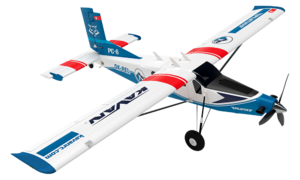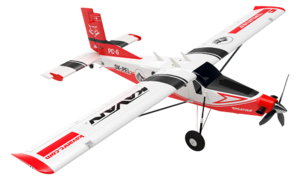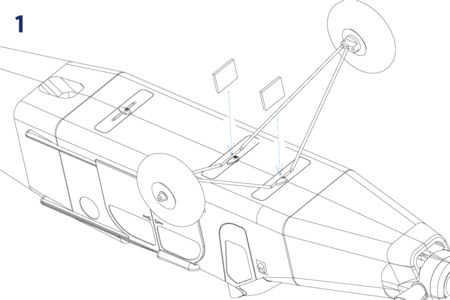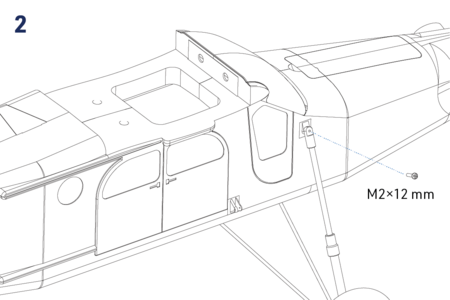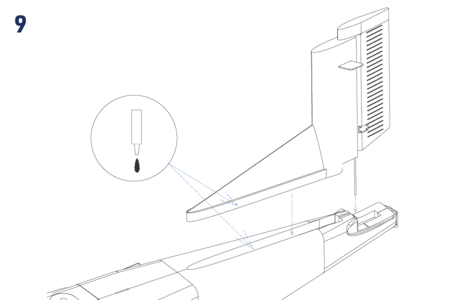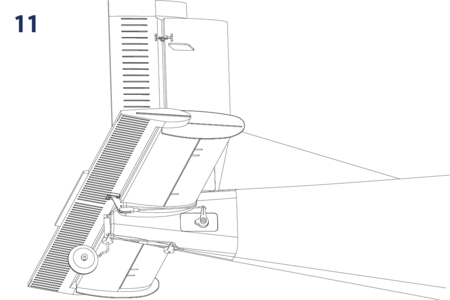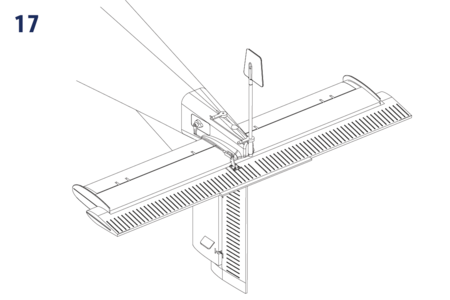KAVAN Pilatus PC-6 Porter - Návod ke stavbě
Úvod
Blahopřejeme vám k zakoupení polomakety švýcarského užitkového letadla kategorie STOL Pilatus PC-6 Porter. Stali jste se majiteli modelu s konstrukcí z takřka nerozbitného pěnového EPO (extrudovaný polyolefin) poháněného výkonným střídavým motorem napájeným z LiPo akumulátorů. Každý, kdo již zvládá létání s modelem s křidélky, si stoprocentně užije pilotáž této elegantní polomakety!
Pilatus PC-6 Porter/Turbo-Porter
| Technické specifikace (PC-6/B2-H4) | |
|---|---|
| Rozpětí | 15,87 m |
| Délka | 10,90 m |
| Základní provozní hmotnost | 1 250 kg |
| Maximální vzletová hmotnost | 2 800 kg |
| Maximální cestovní rychlost | 232 km/h (125 KTAS) |
| Vzdálenost vzletu (překážky nad 15 m) (STOL) | 440 m |
| Přistávací vzdálenost (překážky nad 15 m) (STOL) | 315 m |
| Motor: | Pratt & Whitney Canada PT6A-27 |
| Více informací naleznete zde: https://www.pilatus-aircraft.com. | |
Jednomotorový švýcarský užitkový letoun Pilatus PC-6 Porter, původně poháněný plochým šestiválcovým motorem Lycoming, uskutečnil svůj první let v roce 1959. Brzy následoval vylepšený Turbo-Porter poháněný turbovrtulovým motorem. V průběhu let vynášely tento krásný letoun na oblohu turbovrtulové motory Turbomeca Astazou II, Garret Air Research TPE 331 a nakonec Pratt & Whitney Canada PT6A (asi 70 % všech kdy vyrobených PC-6).
Neuvěřitelné, téměř vrtulníkové schopnosti krátkého vzletu a přistání si rychle získaly pozornost vojenských i komerčních provozovatelů. Vybaveny kolovými podvozky, lyžemi nebo plováky slouží Portery spolehlivě a neúnavně po celém světě - létají nad pouštěmi, džunglemi, jezery, horami, sněhem a ledem - prostě všude. Není divu, že PC-6 drží světový rekord v přistání letadla s pevnými křídly, a to ve výšce 5 750 m (18 865 stop) na ledovci Dhaulagiri v Nepálu.
Po 604 dodávkách za 63 let ukončil Pilatus výrobu v roce 2022...
Ještě než začnete
- Pokud zatím nejste zkušený pilot RC modelů, začněte vyhledávat zkušeného modeláře, který před prvním vzletem zkontroluje váš nový model, zalétá jej a vytrimuje a poskytne vám pomoc během prvních letů. RC modely jsou přece jen poněkud složité, a zkušený modelář může rychle prověřit váš model - a vy získáte jistotu, že úspěchu prvních letů nestojí nic v cestě.
- Prosíme, model sestavujte přesně podle návodu. Nepokoušejte se model jakýmkoliv způsobem upravovat nebo měnit, protože tím můžete způsobit zhoršení jeho letových vlastností. Pokud provedete jakékoliv úpravy, které nejsou v souladu s tímto návodem, činíte tak výhradně na svoji vlastní odpovědnost.
- Než začnete, prosím, zkontrolujte celý obsah stavebnice podle návodu, abyste měli jistotu, že žádná část nechybí nebo není poškozena. Při rozbalování postupujte, opatrně, nic zbytečně neroztrhávejte a nerozřezávejte - nepočínejte si, prosím, jako netrpělivá novomanželka při rozbalování svatebních darů. Tímto způsobem se také lépe seznámíte se všemi částmi modelu. Pokud zjistíte, že nějaký díl chybí nebo je poškozený, prosím, neprodleně kontaktujte prodejce, u kterého jste model zakoupili. Pozn.: Prodejce nemůže přijmout stavebnice k vrácení, pokud byla stavba zahájena.
- Každý díl před nalepením na místo vyzkoušejte. Před montáží se ujistěte, že používáte správný díl a že dobře sedí. Žádné množství lepidla nemůže nahradit špatně padnoucí díl.
- Návod obsahuje zřetelně vyznačenou polohu těžiště a doporučené výchozí velikosti výchylek ovládacích ploch. Dodržení správné polohy těžiště je naprosto zásadní podmínkou pro to, aby byl model ovladatelný a letuschopný. Správnou polohu je nutno bezpodmínečně dodržet. Pro první vzlet model zkompletujte tak, aby těžiště odpovídalo údaji v návodu - to je bezpečná hodnota pro zkušeného pilota, který je seznámen s chováním modelu v plném rozsahu běžných letových rychlostí. Těžiště více vpředu znamená model „hodnější“, stabilnější a snáze ovladatelný. Zadní poloha těžiště značí model „živější“, s menší stabilitou, s rychlejšími reakcemi na řízení a celkově náročnější na ovládání - proto je vhodné začít s přední polohou těžiště, a teprve poté, co s pilotáží modelu seznámíte a sžijete, můžete začít experimentovat.
Zásady bezpečného provozu
Tento RC model není hračka. Používejte jej opatrně a důsledně dodržujte pokyny uvedené v tomto návodu.
Model sestavte přesně podle tohoto návodu. Model NEMODIFIKUJTE ani neupravujte. V opačném případě záruka automaticky zaniká. Postupujte podle pokynů, abyste na konci montáže získali bezpečný a pevný model.
Osoby mladší 14 let smějí model používat pouze pod dohledem dospělé osoby.
Assure that the model is in perfect condition before every flight, taking care that all the equipment works correctly and that the model is undamaged in its structure.
Létejte pouze ve dnech se slabým větrem a na bezpečném místě mimo dosah překážek.
Všeobecná upozornění
- RC letadlo není hračka! Při nesprávném použití může způsobit vážná zranění a škody na majetku. Létejte pouze na bezpečném místě a dodržujte všechny pokyny a doporučení uvedené v tomto návodu. Pozor na vrtuli! Volné předměty, které se mohou do vrtule namotat, včetně volného oblečení nebo jiných předmětů jako jsou tužky a šroubováky, držte mimo dosah točící se vrtule. Zajistěte, aby se vaše ruce, obličej a ruce ostatních osob nacházely mimo dosah rotující vrtule.
- As the user of this product, you are solely responsible for operating it in a manner that does not endanger yourself and others or result in damage to the product or the property of others. This model is controlled by a radio signal that is subject to interference from many sources outside your control. This interference can cause momentary loss of control, so it is advisable to always keep a safe distance in all directions around your model, as this margin will help to avoid collisions or injury.
- Never operate your model with low transmitter batteries.
- Always operate your model in an open area away from power lines, cars, traffic, or people. Avoid operating your model in populated areas where injury or damage can occur.
- Carefully follow the directions and warnings for this and any optional support equipment (chargers, rechargeable batteries, etc.) which you use.
- Keep all chemicals, small parts and anything electrical out of the reach of children.
- Moisture causes damage to electronics. Avoid water exposure to all equipment not specifically designed and protected for this purpose.
- The model is made mostly of plastics - it is not fireproof. It may not be exposed to higher temperatures, otherwise severe distortion of the foam airframe or other damage may occur.
Technical specifications
| Wingspan | 1500 mm |
| Length | 1112 mm |
| All-up weight | 700–770 g |
| Wing Area | 27.9 dm² |
| All-up weight | 1650–1700 g |
| Motor | C3548-750 |
| ESC | KAVAN R-40SB SBEC |
| Propeller | 10×6” 3-blade |
Set contents
Almost ready to fly model o with the brushless motor, speed controller and servos installed, instruction manual.
You will also need
- At least 6-channel RC set, 14.8 V 2600–3300 mAh LiPo flight pack.
- Regular modeller’s tools: modeller‘s knife (KAV66.770), screwdrivers, pliers, No. 10 spanner, 1.5 mm and 2.5 mm Allen keys or screwdrivers, sandpaper etc.
- Glue: Glue: Medium or thick cyanoacrylate glue (e.g. KAV56.9952 or KAV56.9953), silicone or MS polymer glue.
Model assembly
- Push the undercarriage into slots in the bottom of the fuselage until you hear a "Click!", slide in the plastic inserts and secure by rotating the latches.
- Secure the upper undercarriage struts using M2×12 mm screws to the fuselage (do not tighten completely).
- Secure the struts to the undercarriage using M3×10 mm screws. Apply a drop of blue threadlocker to the screws but do not tighten completely.
- Slide the wing halves onto the wing tube joiner.
- Connect the wing multi connectors to the corresponding sockets in the wing halves.
- Hook up your receiver, servos and ESC following the wiring diagram (Fig. 6). The receiver is to be secured with a strip of double-sided foam tape or hook-and-loop tape to the rear part of the cockpit. Deploy the antennas so their active parts are square to each other (if you are using a receiver featuring diversity aerials).Note: The kit is supplied with the connection board for ailerons, flaps, rudder and LED lights so you can use even the most basic 6-channel radios to control your PC-6 Porter. If you intend to use independent control of aileron and flap servos and an advanced computer radio, you have to bypass the connection board accordingly.
The LED lights are only powered via the connection board; they are not remote-controlled in any way. - Attach the wing to the fuselage and secure by the wing joiner plate and two M6×40 mm plastic bolts.
- Attach the wing struts and secure them with two clips each.
- Trial the fit of the horizontal and vertical tailplane and the fuselage - no glue yet. Double check the parts fit tight and the fin is vertical to the horizontal stabilizer. If necessary sand the parts to fit. Once satisfied, apply medium or rather thick cyano (or clear silicone or MS polymer glue) to the contact area of the fin and attach the fin to the fuselage.
- Insert the horizontal tailplane in place and secure it with the M6×40 mm plastic bolt.
- Install the tail wheel and the rudder/tail wheel linkage. Do not forget to apply a drop of blue threadlocker to the setting screws.
- Attach the propeller to the prop driver and secure it with the propeller nut with a washer; tighten the nut using a No. 10 spanner. (For your safety, you should better leave the propeller installation after your radio is all connected and set and the correct direction of rotation of your motor has been tested.) Secure the spinner using an M2.5×20 mm bolt in place.
- Use medium cyano to glue the dummy antennas in place.
- Open the battery compartment hatch, and put your flight pack inside. With your radio on, set the servos to the neutral position (sticks and trims centred) and fasten the setting screws of the pushrod connectors on the elevator and rudder servo arms. Perform the throttle range calibration of the ESC as described in the attachment of this manual.
Float Set Installation (optional - sold separately) - Attach the struts to the floats and secure them with plastic braces and 2.0x10 mm self-tapping screws.
- Push the struts into slots in the bottom of the fuselage until you hear a “Click!”, slide in the plastic inserts and secure by rotating the latches.
- Install the water rudder in place. Do not forget to apply a drop of blue threadlocker to the setting screw.
RC kit installation and pre-flight check
| Recommended throws | *Low Rate | High Rate | ||
|---|---|---|---|---|
| Rate | Expo | Rate | Expo | |
| Ailerons | ±11 mm | 30 % | ±15 mm | 30% |
| Elevator | ±11 mm | 30 % | ±20 mm | 30 % |
| Rudder | ±16 mm | 20% | ±25 mm | 20 % |
| Flaps | Take-off: -10 mm down / Landing: -22 mm down | |||
- Referring to the instruction manual of your radio, carefully hook up the on-board electronics.
- Once everything has been correctly connected, turn on your transmitter and plug in the flight pack. Check the neutral positions and throws of all control surfaces. If you need to make the control surface throws smaller, simply move the pushrod closer to the centre on the servo arm or move it far from the control surface on the control horn. And vice versa.
- Aileron → Rudder: 12 mm left rudder at full left ailerons, 12 mm right rudder at full right ailerons
- Aileron differential: 15 mm up aileron/8 mm down aileron
- Flap → Elevator: 1 mm down elevator for take-off flaps, 2 mm down elevator for landing flaps setting.
- Check the direction of rotation of the propeller. If it is incorrect, simply swap two of the three wires between the ESC and motor or program the ESC (refer to the ESC manual).
- Check the correct position of the centre of gravity (CG): 56–60 mm behind the leading edge of the wing (Fig. 18). Adjust the CG position by moving the flight pack - if you cannot reach the recommended position, do not hesitate to add an appropriate amount of lead to the nose or tail. An extra couple of grams won’t spoil the flying characteristics - but the incorrect CG position is a killer.
- Fully charge your flight pack and transmitter batteries, check the proper function of your radio and perform the range check of your radio according to its instruction manual. The range has to be almost the same with the motor off and at full throttle (no more than a 10% decrease is acceptable). DO NOT try to fly unless the range check is 100% successful.
Flying
The test flying and fine-tuning is pretty much straightforward. There will be no surprise for a medium-advanced pilot who is supposed to fly this model.
"Sea" Porter
It is a good idea to test-fly your Porter with the wheels first just to make yourself familiar with your new model. Explore the safe take-off and landing approach speed, and learn to use the flaps. Once the floats are installed, check again the CG position; adjust the battery position and/or add ballast if necessary.
For the first test flights, seek an open area of calm water. Try to avoid lakes surrounded by tall trees causing turbulence above water. Tall trees would also force a dangerously steep climb right after your model gets into the air. Choose a fine day with a gentle breeze - the take-off is easier when there are small waves than from a glass-still lake.
Prepare the model as usual and check the RC set and power systems are working properly. Place your model in the water, pull the elevator up and gently open the throttle to taxi away from the bank. The model should be easy to control thanks to the efficient water rudder. Once away enough, switch the motor off, and the model will turn itself directly against the wind thanks to the "weathercock" effect of the fin.
Open the throttle and allow your model to gain speed until it rises onto the step of the floats. Leave the elevator at the neutral position; do not apply the up elevator until the model actually gains the take-off speed (a little bit bigger than with wheels). Gently apply the elevator. Do not force your model into a steep climb or sharp turn. The increased drag caused by the floats makes your Porter respond more slowly. The level flight also requires a higher throttle setting. Allow your model to climb to a safe height (50 m or so), and take your time to get the feel of your new floatplane. You should try a couple of landing approaches - at first at a safe height, and at a low level later.
However, do not get carried away by your beautiful seaplane. Remember you have to spare enough energy not only for a safe landing but also for taxiing back. Allow your model to descend steadily by keeping the throttle a little bit more open than with a land-based plane. Let your model touch down gently and smoothly on the water.
Once "docked", check if there is no water inside your model. Dry it thoroughly with a sponge if necessary. Check for any signs of damage by objects in the water and thoroughly check the water rudders.
At the end of your water flying session, carefully and thoroughly clean and dry your model from outside and inside. It is wise to carry a bottle of fresh water, a sponge and a piece of fine dry cloth with you to the lake. The exposed metal fittings might be happier if protected by a drop of WD-40 spray lube.
Appendix
Recycling and Waste Disposal Note (European Union)

Electrical equipment marked with the crossed-out waste bin symbol must not be discarded in the domestic waste; it should be disposed of via the appropriate specialised disposal system. In the countries of the EU (European Union) electrical devices must not be discarded via the normal domestic waste system (WEEE - Waste of Electrical and Electronic Equipment, Directive 2012/19/EU). You can take your unwanted equipment to your nearest public collection point or recycling centre, where it will be disposed of in the proper manner at no charge to you. By disposing of your old equipment in a responsible manner you make an important contribution to the safeguarding of the environment!
EU Declaration of Conformity (European Union)

Hereby, KAVAN Europe s.r.o. declares that this Pilatus PC-6 Porter model and the included electronic and electric devices are in compliance with the requirements of relevant European directives and harmonized norms. The full text of the Declaration of Conformity is available at www.kavanrc.com/doc/.
Guarantee
The KAVAN Europe s.r.o. products are covered by a guarantee that fulfils the currently valid legal requirements in your country. If you wish to make a claim under guarantee, please contact the retailer from whom you first purchased the equipment. The guarantee does not cover faults which were caused in the following ways: crashes, improper use, incorrect connection, reversed polarity, maintenance work carried out late, incorrectly or not at all, or by unauthorised personnel, use of other than genuine KAVAN Europe s.r.o. accessories, modifications or repairs which were not carried out by KAVAN Europe s.r.o. or an authorised KAVAN Europe s.r.o., accidental or deliberate damage, defects caused by normal wear and tear, operation outside the Specification, or in conjunction with equipment made by other manufacturers. Please be sure to read the appropriate information sheets in the product documentation.
